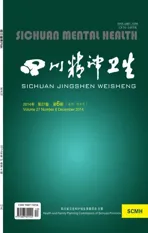青少年非自杀性自伤危险因素的研究进展
2014-06-26万里洋综述本刊审校
万里洋 况 利 综述 本刊审校
非自杀性自伤(non-suicidal self-injury,NSSI)是指不含自杀意图的情况下,直接、故意、反复伤害自己身体,且不会导致死亡的行为[1]。NSSI在青少年中日益普遍,在社区人群中NSSI的比例为15%~32.7%[2-3],而在精神障碍人群中高达40%~87%[4-5]。且有研究提示到2020年估计有15~30百万的青少年将加入自伤行为行列[6-7],目前已将NSSI纳入了《精神疾病诊断与统计手册(第5版)》(Diagnostic and Statistical Manual of Mental Disorders Fifth edition,DSM-V)的诊断草案当中,说明其已经成为一个重要的精神卫生问题,严重影响着青少年的心理健康水平。虽然NSSI与自杀未遂有本质上的区别,但大多数研究表明具有NSSI的青少年有很高的自杀风险[8-10],有研究表明发生过NSSI的青少年70%以上曾经或现在有自杀观念[11-12],有研究提示具有NSSI的青少年在随访的一年期间有10.9%的青少年至少有过一次自杀未遂[13]。如果充分了解了该行为的危险因素,可制定有效的干预措施。NSSI是由多种因素作用的结果,如遗传、精神心理疾病、社会环境等。本文就NSSI的社会家庭环境及精神心理因素做一综述。
1 社会因素
1.1 年龄及性别 NSSI初发多在青春期早期,其中因NSSI住院的人群中以20~29岁者最常见[1]。一些研究提示NSSI的发生率在性别上差异有统计学意义,有研究表明女性发生率大于男性[14-17],因为女性较容易受外界影响,更加缺乏自信,具有高的情绪反应[16],更依赖于NSSI去缓解自己的负性情绪[14]。但也有研究提示性别差异性不显著[18-19],且中国有一项研究提示男性发生率大于女性[20]。也有研究表明男性与女性采取NSSI的方式也有差异,女性多采用切割、在皮肤或指甲内植入异物、抓伤的方式,男性多采用剥皮、击打、烧灼的方式[14,21-22]。有报道表明发生NSSI的女性情绪常常较不稳定,具有精神心理疾患[5],而男生常常有抑郁情绪、绝望感、幼年的性侵害[14-15]。
1.2 性取向、性行为、跨性别 有研究表明过早的性行为(小于15岁)、同性恋、双性恋[6,23]、同性性行为可增加NSSI的风险[24]。具有过早的性行为的青少年大多较冲动。而同性恋、双性恋及同性性行为的青少年NSSI风险增加的原因可能是部分地区同性恋虽然已经合法,但是在大多数地区同性恋仍未得到认可,这部分人群将承受更多社会道德和舆论的压力,且青少年相对于成年人来说阅历不足,面对自己不同于其他人的性向更迷茫,就有可能有更多的心理健康问题,从而增加NSSI的发生率。有研究报道,跨性别人群的个体内在及人际方面的问题更多,得到的家庭、社会的支持更少,从而发生NSSI的风险更高[25]。
1.3 书籍、媒体、网络 研究表明书籍、媒体、网络过度的渲染NSSI的情节,注重细节,而青少年对其识别能力低于成年人,若没有正确的引导,容易暗示青少年,使其效仿或加强NSSI[26]。
1.4 学校环境 大多青少年主要的活动范围除了家就是学校,所以学校环境对青少年的成长发育、认知行为的养成至关重要。如学业压力过大、与同学(男生常表现为身体攻击,女生常为关系攻击)或老师关系紧张对于情绪调节障碍的青少年,可成为NSSI的触发因素[27]。同学和老师若能够及时给予关注及支持,可以缓解青少年的焦虑、敌对情绪,让其具有安全感[24]。且青少年更容易受同伴的影响,可从具有NSSI的同伴处习得,或让同伴认同自己[27]。
2 家庭环境
家庭是青少年主要的生活环境之一,对青少年身心发展起着重要的作用,是无可替代的。
2.1 与家庭成员的关系 研究显示父母严厉的教养模式容易使青少年产生逆反心理,更多的表现为攻击行为及抑郁情绪,从而增加NSSI的发生[27-28]。同时过度保护、溺爱孩子、家庭暴力、对其关注太少,容易使青少年情绪调节异常、适应不良、人格发育障碍、不自信[27-30],青少年为了改变与父母的关系或得到更多的关注而采取该行为[9]。且具有离家出走史的青少年发生NSSI的几率也增高[9,15,29]。研究表明良好的家庭关系,可以在青少年的成长过程中给以稳定的支持,使青少年有安全感,从而减少NSSI[12,15]。
2.2 家庭成员结构 完整和睦的家庭可给予青少年更多的情感支持,其人格发育更加健全。单亲家庭成因不尽相同,不论是离异、配偶死亡、未婚先孕等,单亲家庭的子女更容易出现心理问题,如自卑、抑郁、焦虑、自责、逆反等,从而增加了青少年的NSSI发生率[31]。在中国,家庭里多为独生子女,但研究显示独生子女不是NSSI的危险因素[32]。
2.4 亲友的NSSI或有抑郁症 家庭中长辈是青少年学习的榜样,若家庭中有NSSI史,青少年为了改善不良的情绪或为了逃避责任,就很可能效仿该行为[26]。有研究提示患有抑郁症的父母其子女容易发生NSSI[23,33]。
3.5 家庭文化程度及经济情况 研究发现父母文化程度较低、家庭的经济情况较差[15,34]的青少年更容易发生NSSI。因为当青少年遇到困扰及挫折时,父母不能给予很好的支持,同时不能积极的寻求其他社会支持。
3 精神心理因素
3.1 性格 有研究表明,具有内向、自卑、情绪稳定性差[27]、攻击性强(包括言语和躯体的攻击)[35-36]、冲动[24-25,32]性格特征的青少年更易发生NSSI。相对于外向的青少年,内向的青少年负性情绪的发泄渠道减少,而且大多内向的青少年多有自卑感,若遇到一定的应激事件,将出现一定的情绪调节困难,可能会以NSSI来缓解负面情绪。但有研究表明,“书呆子”不增加NSSI的风险,爱运动的青少年可减少NSSI的发生[31]。较冲动的青少年,做事不考虑后果,以极端的方式解决问题、逃避惩罚,容易发生NSSI。
3.2 精神障碍 青少年是一个处在不断发展、学习、变化过程中的个体,在不同的年龄阶段,情感、认知、意志、行为也不同,所处的生活环境也在不断变化,青少年需要不断适应、改变,承受来自学习及生活的压力,容易产生心理问题,甚至严重的精神障碍。有研究显示精神障碍患者的NSSI发生率极高。其中抑郁情绪是重要独立危险因素[5,20]。同时边缘性人格障碍[35,37]、广泛性焦虑障碍[9,38]、社交恐惧症[9,38]、神经症[14,31]、创伤后应激障碍[28]也是危险因素。青少年为了改善负性情绪,获得愉悦感,减少恐惧而采取NSSI。NSSI是情绪调节异常的表现。同时情绪调节异常的青少年也常表现为进食障碍[39]、物质滥用[5]。有研究表明,进食障碍及物质滥用的青少年较对照组NSSI有更高的发生率[18]。
4 负性生活事件
负性生活事件作为一种应激源,对于情绪调节异常的青少年,可诱发NSSI。青少年阶段生长智力逐渐成熟,情感趋于稳定,自我意识逐渐膨胀,与外界接触增多,若没有良好的适应能力、自我调节能力,若遇到负性生活事件,如不良的同学关系、自然灾害、性虐待等[12,14,17,27,29-30],将体验到更多的焦虑、抑郁等负性情绪,从而采取消极的应对方式、过激的行为缓解负性情绪或惩罚自己[31,35],甚至一部分会出现创伤后应激障碍,NSSI的发生率也大大增加。
5 小 结
青少年NSSI的影响因素多种多样,既有遗传、社会、家庭、个人精神心理特征的长期因素,也有负性生活事件的诱发因素。消极的归因方式[20]、外界环境的压力[23]是使NSSI慢性化的危险因素。NSSI的发生更多地受个体内在因素的影响[16,37],如情绪调节异常、自卑、抑郁、焦虑、冲动[16]。其中NSSI与自杀的关系既有区别也有联系。一种观点认为NSSI是为了避免自杀,另一种观点认为NSSI可增加自杀的风险,是自杀的练习,大多数的研究支持后一种观点[40]。NSSI发展为自杀的主要风险因素为男性[9](但中国有一项研究提示女性与男性相当[32])、反复NSSI[15,31]、绝望心境、暴力的自伤方式、行为冲动[32]、精神障碍[12]、不良的家庭关系[12,24]。可见青少年NSSI是严峻的公共卫生问题,需要建立更为积极的预防及干预措施[40]。通过对危险因素的了解,对制定预防及干预措施有极大的帮助。首先要预防NSSI的发生,比如加强青少年的精神心理健康教育,有利于青少年良好人格、积极的应对方式、较强的适应能力的形成。改善家庭、学校、社会环境,给青少年安全感。一些可诱发NSSI的书籍、网络、媒体信息建议通过有关部门的审核。其次对于有发生NSSI风险的青少年,能够及时发现并给予有效的干预,而学校是青少年最主要的生活区域,学校应该建立一套及时、专业的筛选高危人群的系统,定时的问卷调查,并对工作人员及家长进行培训。最后对于已经发生NSSI的青少年,应该及时发现及有效干预,通过了解其发生NSSI的因素,包括自身及外界环境因素,评估再次发生NSSI的危险度,而对其进行针对性的干预。今后对NSSI的关注及监测水平有待提高,有必要建立一套完整的监测青少年NSSI的系统,支持NSSI的研究,拟定有效的干预措施。
[1] American Psychiatric Association. DSM-5TM[M]. American Psychiatric Publishing,2013:803-806.
[2] Nixon MK, Cloutier P, Jansson SM. Nonsuicidal self-harm in youth: a population-based survey[J].CMAJ,2008,178(3):306-312.
[3] Shek DTL, Yu L. Self-harm and suicidal behaviors in Hong Kong adolescents: prevalence and psychosocial correlates[J]. Scientific World Journal,2012,2012:932540.
[4] Nock MK, Prinstein MJ. A functional approach to the assessment of self-mutilative behavior[J]. J Consult Clin Psychol,2004,72(5):885-890.
[5] Preyde M, Vanderkooy J, Chevalier P, et al. The psychosocial characteristics associated with NSSI and suicide attempt of youth admitted to an in-patient psychiatric unit[J].J Can Acad Child Adolesc Psychiatry,2014,23(2):100-110.
[6] Collins PY, Patel V, Joestl SS, et al. Grand challenges in global mental health[J]. Nature,2011,475(7354):27-30.
[7] Batejan KL, Jarvi SM, Swenson LP. Sexual Orientation and Non-Suicidal Self-Injury: A Meta-Analytic Review[J]. Arch Suicide Res,2014.
[8] Wilkinson P, Kelvin R, Roberts C, et al. Clinical and psychosocial predictors of suicide attempts and nonsuicidal self-injury in the Adolescent Depression Antidepressants and Psychotherapy Trial (ADAPT)[J]. Am J Psychiatry,2011,168(5):495-501.
[9] Klonsky ED, May AM, Glenn CR. The relationship between nonsuicidal self-injury and attempted suicide: converging evidence from four samples[J].J Abnorm Psychol,2013,122(1):231-237.
[10] Zetterqvist M, Lundh LG, Svedin CG. A comparison of adolescents engaging in self-injurious behaviors with and without suicidal intent: self-reported experiences of adverse life events and trauma symptoms[J].J Youth Adolesc,2013,42(8):1257-1272.
[11] Nock MK, Joiner TE Jr, Gordon KH, et al. Non-suicidal self-injury among adolescents: Diagnostic correlates and relation to suicide attempts[J]. Psychiatry Res,2006,144(1):65-72.
[12] Wolff J, Frazier EA, Esposito-Smythers C, et al. Cognitive and social factors associated with NSSI and suicide attempts in psychiatrically hospitalized adolescents[J].J Abnorm Child Psychol,2013,41(6):1005-1013.
[13] Tang J, Yu Y, Wu Y, et al. Association between non-suicidal self-injuries and suicide attempts in Chinese adolescents and college students: a cross-section study[J]. PLoS one,2011,6(4):e17977.
[14] Albores-Gallo L, Méndez-Santos JL, Xóchitl-García Luna A,et al. Nonsuicidal self-injury in a community sample of older children and adolescents of Mexico city[J]. Actas Esp Psiquiatr,2014,42(4):159-168.
[15] Taliaferro LA, Muehlenkamp JJ, Borowsky IW,et al. Factors distinguishing youth who report self-injurious behavior: A population-based sample[J]. Acad Pediatr,2012,12(3):205-213.
[16] Tatnell R, Kelada L, Hasking P, et al. Longitudinal Analysis of Adolescent NSSI: The Role of Intrapersonal and Interpersonal Factors[J].J Abnorm Child Psychol,2014,42(6): 885-896.
[17] Liu RT, Frazier EA, Cataldo AM, et al. Negative life events and non-suicidal self-injury in an adolescent inpatient sample[J]. Arch Suicide Res,2014,18(3):251-258.
[18] Wan YH, Xu SJ, Chen J, et al. Longitudinal effects of psychological symptoms on non-suicidal self-injury: a difference between adolescents and young adults in China[J].Soc Psychiatry Psychiatr Epidemiol, 2014.
[19] Klonsky ED. Non-suicidal self-injury in United States adults: prevalence, sociodemographics, topography and functions[J]. Psychol Med,2011,41(9):1981-1986.
[20] Barrocas AL, Giletta M, Hankin BL, et al. Nonsuicidal self-injury in adolescence: longitudinal course, trajectories, and intrapersonal predictors[J]. J Abnorm Child Psychol, 2014.
[21] Andover MS, Gibb BE. Non-suicidal self-injury, attempted suicide, and suicidal intent among psychiatric inpatients[J].Psychiatry Res,2010,178(1):101-105.
[22] Kerr PL, Muehlenkamp JJ. Features of psychopathology in self-injuring female college students[J].J Ment Health Couns,2010,32(4):290-308.
[23] Wilcox HC, Arria AM, Caldeira KM, et al. Longitudinal predictors of past-year non-suicidal self-injury and motives among college students[J]. Psychol Med,2012,42(4):717-726.
[24] Wichstrøm L. Predictors of non-suicidal self-injury versus attempted suicide: similar or different?[J]. Arch Suicide Res,2009,13(2):105-122.
[25] Claes L, Bouman WP, Witcomb G, et al. Non‐Suicidal Self‐Injury in Trans People: Associations with Psychological Symptoms, Victimization, Interpersonal Functioning, and Perceived Social Support[J]. J Sex Med, 2014.
[26] Lewis SP, Heath NL, Michal NJ, et al. Non-suicidal self-injury, youth, and the Internet: What mental health professionals need to know[J]. Child Adolesc Psychiatry Ment Health,2012,6(1): 13.
[27] Keenan K, Hipwell AE, Stepp SD, et al. Testing an equifinality model of nonsuicidal self-injury among early adolescent girls[J]. Dev Psychopathol, 2014, 26(3): 851-862.
[29] Taliaferro LA, Muehlenkamp JJ, Borowsky IW, et al. Factors distinguishing youth who report self-injurious behavior: A population-based sample[J]. Acad Pediatr,2012,12(3):205-213.
[30] Auerbach RP, Kim JC, Chango JM, et al. Adolescent nonsuicidal self-injury: Examining the role of child abuse, comorbidity, and disinhibition[J]. Psychiatry Res,2014,220(1-2):579-584.
[31] Young R, Sproeber N, Groschwitz RC, et al. Why alternative teenagers self-harm: exploring the link between non-suicidal self-injury, attempted suicide and adolescent identity[J].BMC psychiatry, 2014,14(1):137.
[32] Liang S, Yan J, Zhang T, et al. Differences between non-suicidal self injury and suicide attempt in Chinese adolescents[J].Asian J Psychiatr,2014,8:76-83.

[34] Law CK, Yip PSF, Chan WSC, et al. Evaluating the effectiveness of barrier installation for preventing railway suicides in Hong Kong[J]. J Affect Disord,2009,114(1-3):254-262.
[35] You J, Lin MP, Leung F. A Longitudinal Moderated Mediation Model of Nonsuicidal Self-injury among Adolescents[J]. J Abnorm Child Psychol,2014.
[36] Tang J, Ma Y, Guo Y, et al. Association of aggression and non-suicidal self injury: a school-based sample of adolescents[J]. PLoS one,2013,8(10):e78149.
[37] Saraff PD, Pepper CM. Functions, lifetime frequency, and variety of methods of non-suicidal self-injury Among college students[J]. Psychiatry Res,2014,219(2):298-304.
[38] Chartrand H, Sareen J, Toews M, et al. Suicide attempts versus nonsuicidal self‐injury among individuals with anxiety disorders in a nationally representative sample[J]. Depress Anxiety,2012,29(3): 172-179.
[39] Shingleton RM, Eddy KT, Keshaviah A, et al. Binge/purge thoughts in nonsuicidal self-injurious adolescents: An ecological momentary analysis[J].Int J Eat Disord,2013,46(7):684-689.
[40] Victor SE, Klonsky ED. Correlates of suicide attempts among self-injurers: A meta-analysis[J]. Clin Psychol Rev,2014,34(4):282-297.
